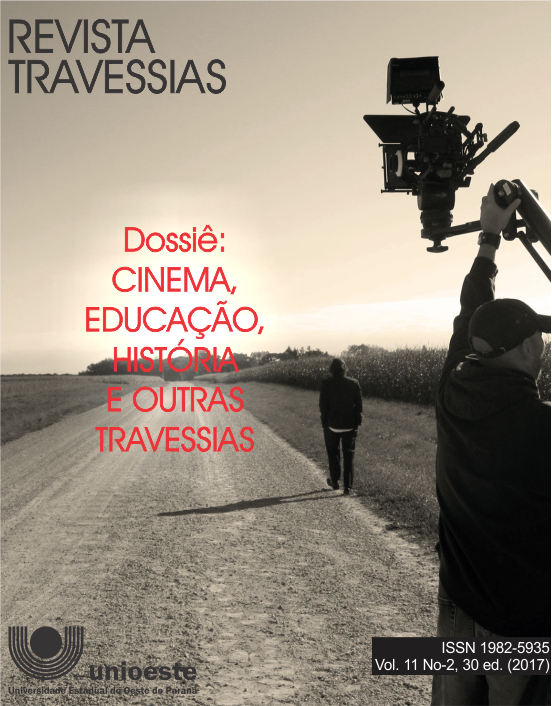Diluted representation of Shoah and Education: the (tele)dramatic model in Jayme Monjardim’s Olga (2004)
Keywords:
Shoah, representation, dilution, Olga BenárioAbstract
Piece of work on the problems of representation of Shoah (“Holocaust”) in film works, based on theoretical notions such as fictional resistance of the trauma, memory, and testimony. Such concepts are present in texts by authors such as Márcio Seligmann-Silva and Berta Waldman. The objective is to make explicit that ethics is compromised when such fictional works use trauma as an expressive element of drama – commotion or "lamentation", according to Primo Levi. This problematic is widened when such films are included in Education as a didactic resource or as a portrait of a historical period. The film work that serves as an example of the debate here presented is Jayme Monjardim’s Olga (2004). The methodology follows this dynamics: 1. reflection on the representation of trauma and its dilution or simplification; 2. The tele(dramatic) model present in Jayme Monjardim's Olga, also the need for teachers and students to distinguish what is "real" and what is stylized (or “staged”) from this "real." In the final considerations, it is proposed that the documentary genre, as well as the literature of testimony, problematize better both Shoah and trauma, especially in the school environment. Both of them are textual materials that alternate attachment and detachment from the traumatic experience, as well as the fragmentation that comes from it, result of its "violent clash".
Downloads
References
ADORNO, Theodor W.;HORKHEIMER, Max. A indústria cultural: o esclarecimento como mistificação das massas. In: Dialética do esclarecimento – fragmentos filosóficos. Rio de Janeiro: Zahar, 1985.
BENJAMIN, Walter. A obra de arte na época da sua reprodutibilidade técnica. In: LIMA, Luiz Costa. Teoria da Cultura de Massa. Rio de Janeiro: Paz e Terra, 1990, p. 215-254.
______. Passagens. Belo Horizonte: UFMG, 2006.
CORTINA, Arnaldo; SILVA, Fernando Moreno. Um olhar sobre a leitura de best-seller. Travessias, PR, v.2, n.1, p.1-19, 2008.
DW – Deutsche Welle. Filme “Olga” decepciona crítica alemã. Disponível em: http://www.dw.com/pt-br/filme-olga-decepciona-cr%C3%ADtica-alem%C3%A3/a-2167052. Acesso em: 1 ago. 2017.
GINZBURG, Carlo. Mitos, emblemas, sinais – Morfologia e história. São Paulo: Companhia das Letras, 1991.
JAMESON, Fredric. As marcas do visível. Rio de Janeiro: Graal, 1995.
KURTZ, Adriana. O cinema depois de Auschwitz: os dilemas da representação do Holocausto. Devires, MG, v.3, n.1, p.46-63, 2006.
LEVI, Primo. Os afogados e os sobreviventes. Rio de Janeiro: Paz e Terra, 1990.
MENDONÇA, Martha;MARTINS, Elisa. Um mito chamado Olga. Época. ago, 2004. Disponível em: http://revistaepoca.globo.com/Revista/Epoca/0,,EDR65925-6011,00.html. Acesso em: 1 ago. 2017.
MUNIZ, Veyzon Campos. O caso Olga Benario Prestes: um estudo crítico sobre o habeas corpus nº 26.155/1936. Direito&Justiça, RS, v.37, n.1, p.36-60, 2011.
MURACA, Márcio Henrique. Que seria na realidade o judeu de Jorge Amado, Graciliano Ramos e Rachel de Queiroz?. Vértices, SP, v.17, p.65-71, 2014.
OLGA. Jayme Monjardim. Brasil: Lumière: Globo Filmes, 2004. DVD (141 mim.), Drama, son. (port.), color, NTSC.
OLGA BENÁRIO – Uma vida pela Revolução. Galip Iytanir. 2003. Disponível em: https://www.youtube.com/watch?v=hAJS30qEWtM. Acesso em: 1 ago. 2017.
SELIGMANN-SILVA, Márcio (Org.). História, memória, literatura – o testemunho na Era das Catástrofes. Campinas: Unicamp, 2003.
TUCCI CARNEIRO, Maria Luiza. O antissemitismo na era Vargas – Fantasmas de uma geração (1930-1945). São Paulo: Perspectiva, 2001.
WALDMAN, Berta. Sobrevoando Auschwitz: As aves da noite [de Hilda Hilst]. In: NASCIMENTO, Lyslei;JEHA, Julio (Org.). Estudos Judaicos: Shoá, o mal e o crime. São Paulo: Humanitas, 2012. p.13-33.
WIAZOVSKI, Taciana. O mito do complô judaico-comunista no Brasil – Gênese, difusão e desdobramentos (1907-1954). São Paulo: Humanitas, 2008.
Downloads
Published
How to Cite
Issue
Section
License
Creative Copyright Notice
Policy for Free Access Journals
Authors who publish in this journal agree to the following terms:
1. Authors keep the copyright and grant the journal the right of first publication, with the work simultaneously licensed under the Creative Commons Attribution License, which allows sharing the trial with acknowledgment of authorship and initial publication in this journal.
2. Authors are authorized to take additional contracts separately, for non-exclusive distribution of the work version, published in this journal (eg publish in institutional repository or as a book chapter), with acknowledgment of authorship and initial publication in this journal.
3. Authors are allowed and encouraged to publish and distribute their work online (eg in institutional repositories or on their personal page) at any point before or during the editorial process, as this can generate productive changes, as well as increase both impact and citation of the published trial (See The Effect of Free Access).
Creative Commons License
This work is licensed under a Creative Commons Attribution–NonCommercial-shareaswell 4.0 International License, which allows you to share, copy, distribute, display, reproduce, completely or part of the work, since there is no commercial purpose, and authors and source are cited.



